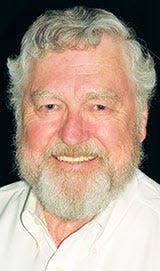'Disappearing Appalachia in Tennessee
Carolyn Krause brings us an alarmingly simple but profound observation about our region of Appalachia. At a recent Oak Ridge Institute for Continued Learning class, Harry Moore and Fred Brown brought their book, "Disappearing Appalachia in Tennessee: A Picture of a Vanished Land and its People" to life. Carolyn graciously captured that presentation for "Historically Speaking."
***
Tennessee is losing the Appalachian way of life, including its distinctive buildings, bridges, language, and music.
“This vast region that was once a stronghold of firs, farmland and barns stuffed with hay, corn and tobacco is disappearing beneath layer upon layer of asphalt, sprawling cities and the spread of suburbs into what once were lush fields.”
This quote is from "Disappearing Appalachia in Tennessee: A Picture of a Vanished Land and Its People." The authors of this book, published in 2021 by UT Press, are Harry Moore and Fred Brown. Earlier this year, they told stories and presented slides of photographs from the book to an Oak Ridge Institute for Continued Learning class.
Moore, who took beautiful black-and-white photos of Appalachian buildings and structures still standing in East Tennessee, is a retired engineering geologist from the Tennessee Department of Transportation and more recently Golder Associates in Atlanta, where he worked a combined 47 years studying the geology of East Tennessee and surrounding regions. Since 1972 he has been involved in the planning, design, construction, and maintenance of East Tennessee’s road system.
An award-winning journalist whose assignments took him from the end zones as a sportswriter to several war zones as an embedded reporter, Brown completed his 45-year career as a senior writer who penned regional history stories and features for the Knoxville News Sentinel.
Brown read his descriptions of the “hardy souls” who came here from Great Britain and “braved the extraordinary elements, natural and man-made” to build homes, raise families and plant “long row crops in the rich valleys, high meadows and gently rolling foothills.” He painted a picture of family farms that “spread along dusty roads bisecting thick forests of oak, hickory, poplar, dogwood, hemlocks and firs.”
The “rolling hills, rivers, mountains and flatland farms” of East Tennessee are part of Appalachia, which Brown described as “a great swath of states encompassing 205,000 square miles along the spine of the Great Appalachian Mountains. This rugged chain of mountains extends from New York to Mississippi — some 12 states and all of West Virginia compose what is known as Appalachia. East Tennessee borders six of the 12 other states. Tennessee itself borders seven of the 12 states.”
Economically, conditions have changed in Appalachia.
"Farmers once produced all they needed for themselves and their families with enough left over to sell to neighbors or to the market,” Brown said. “Life was good. Families prospered and children grew up in a region of quiet civility and respect.”
Today, poverty rates and unemployment in the Southern Appalachian counties bordering Tennessee are higher and the income per capita is lower than the U.S. average. Tobacco farms have vanished, and coal mining has declined as an income source.
“Farmers are aging and the population living on the farm continues to drop,” he added. “East Tennessee’s portion of Appalachia is changing dramatically. Cities are getting bigger; traffic is growing and small towns are struggling to keep a central business district. What we see along East Tennessee back roads are remnants of another time and place.”
He suggested that regional residents have been witnessing the “disassembling of East Tennessee.”
Moore showed photos of various buildings and structures that are “fading from the landscape.” The most interesting buildings include the “great barns with magnificently constructed cantilevers that housed not only farm animals and cribs, but also tobacco hanging to dry and enormous lofts for hay,” Brown said.
Moore explained that a cantilever barn consists of a long “second-floor” structure supported by a much smaller building on the ground. The reason for this design by Scotch-Irish immigrants was the realization that only the square feet of the building touching the ground could be taxed.
He noted that disappearing structures include log cabins made of yellow poplar and oak, one-room schoolhouses, grist mills, general stores, covered bridges and steel-truss bridges. Concrete and steel-beam bridges are replacing the older bridges because they are too narrow and not designed to bear the weight of tractor-trailer trucks. However, he added, most of the old churches have been well preserved because subsequent generations of families that first joined the churches have taken care of the sanctuary buildings.
Brown and Moore drove around East Tennessee and interviewed 15 people in their 80s and 90s who reminisced about the Appalachian way of life.
Glen Cardwell and his family were forced to move from their home because of the establishment in 1934 of the Great Smoky Mountains National Park, but he ended up getting a job there as a naturalist. Robert Nicely lived on the family farm purchased in 1835. He told Brown that the family members spelled their names in different ways (Nicely or Niceley) depending on which political party candidates they were voting for.
The authors dedicated their book to Charlie Cavin because he steered them to interesting people to interview. Cavin was an agricultural extension agent in Grainger County who, Moore said, was “responsible for the popularity of the Grainger County tomatoes. He found a variety of tomatoes that would do well in the county’s soil. He figured out that bumblebees are great pollinators of tomato plants. He taught farmers how to grow and market the famous Grainger County tomatoes.”
A carpenter that Moore met lived in a cave his whole life. He built 12 houses and lived on $300 a year. He had a wood-burning stove in the cave he rented from a farmer for $1 a year. He built a wooden structure over the mouth of the cave to keep heat in and animals out. He washed his clothes in the Holston River.
This man got by without electricity his whole life. When the authors asked the other interviewees which changes they considered improvements in their life, they all answered “electricity,” which was introduced in the late 1930s and early 1940s, with indoor plumbing a close second.
Brown noted the gradual disappearance of the Appalachian language, which combined the language brought here by Scotch-Irish immigrants with the language of mountain folks. Most of us rarely hear Appalachian phrases like "don’t rightly know, them thar holler and hissy fit.”
The author attributed the loss of the Appalachian language and dialects to the intermingling of the residents with people migrating here from all over the nation. Another impact on Appalachians’ way of speaking, they agreed, is television, which presents the uniform Middle America speech of people in commercials, sitcoms, and newscasts.
***
Thank you, Carolyn, for bringing this most interesting book and class to our "Historically Speaking" readers.


This article originally appeared on Oakridger: 'Disappearing Appalachia in Tennessee'
